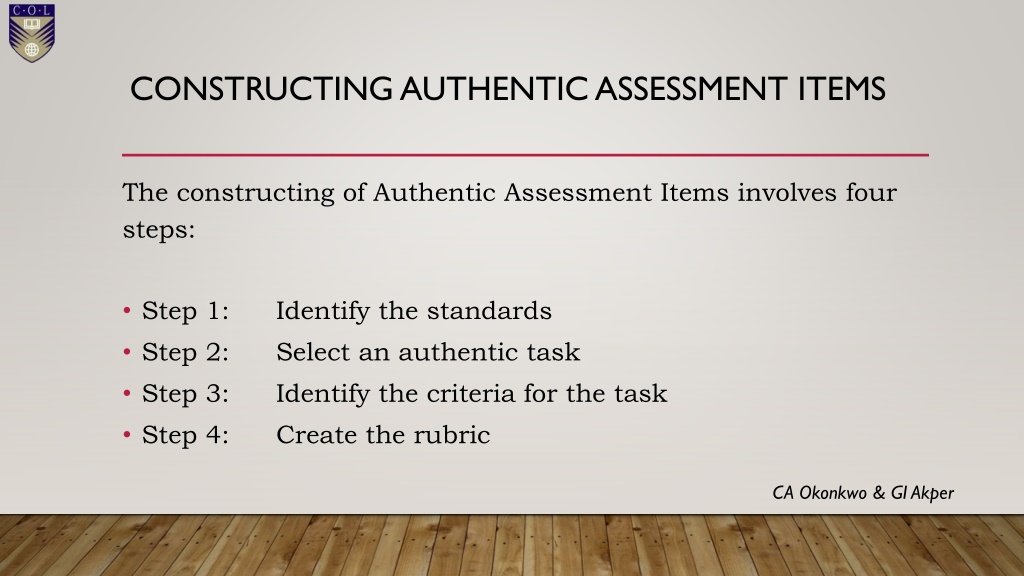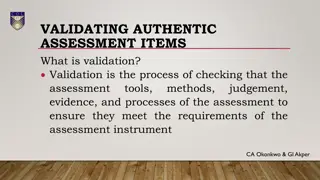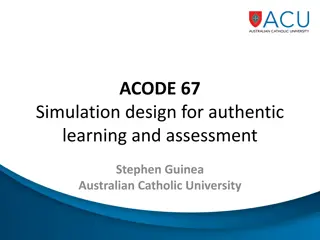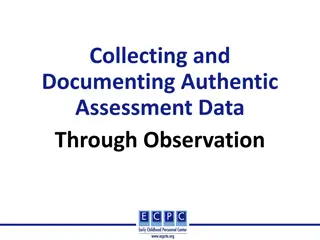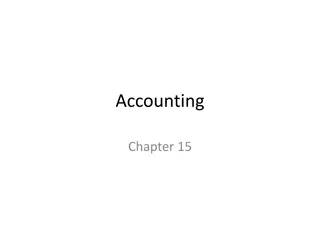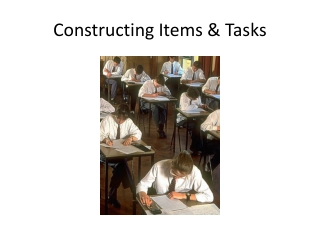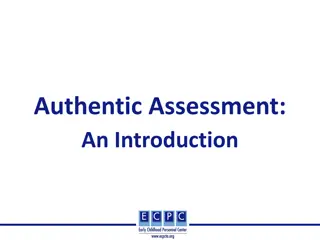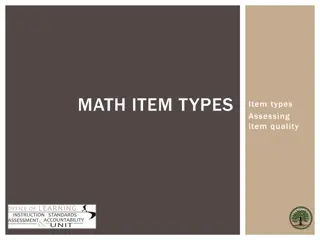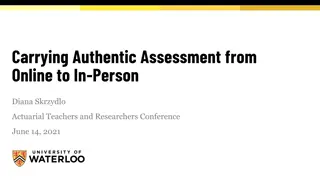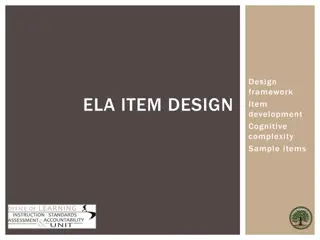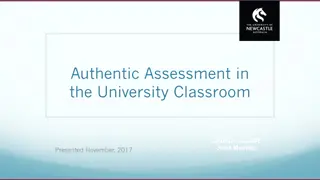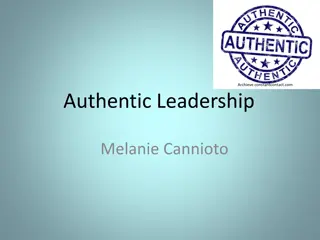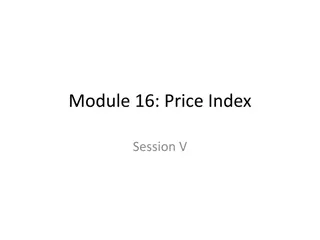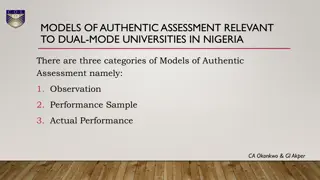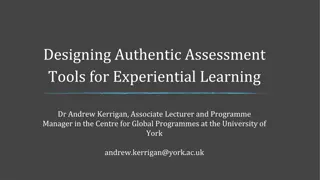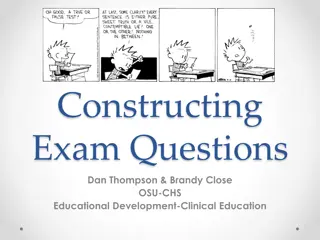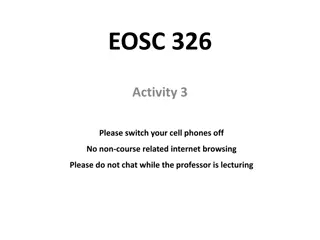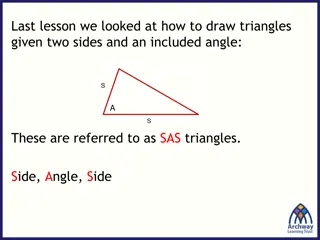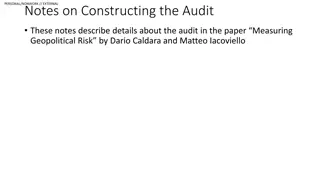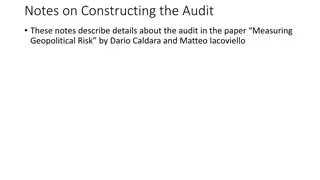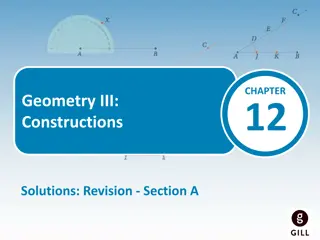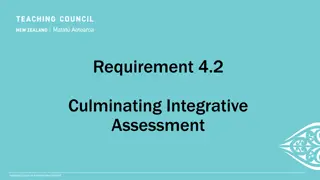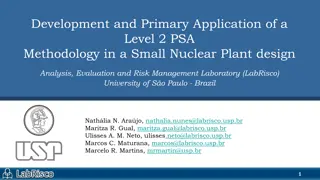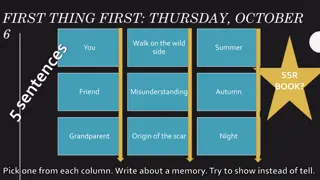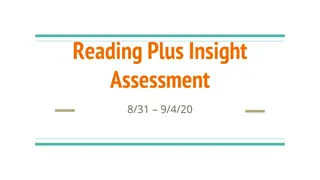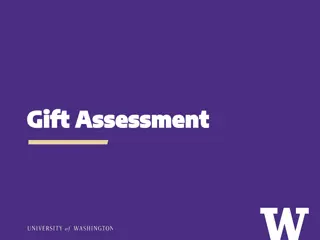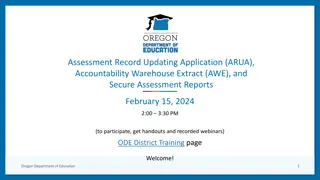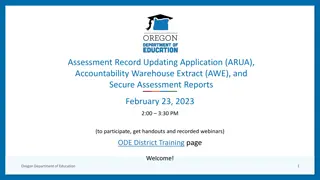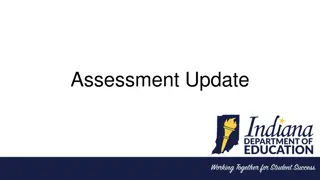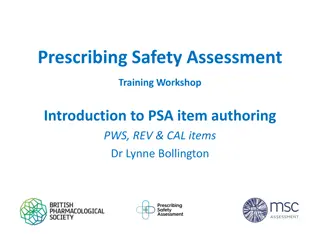Constructing Authentic Assessment Items: A Guide in 4 Steps
Constructing authentic assessment items involves four steps: identifying standards, selecting an authentic task, defining criteria, and creating a rubric. Standards are specific skills and knowledge students should gain. Tasks should reflect these standards. Criteria measure student mastery. Rubrics assess performance based on established criteria. The GRASPS acronym helps in task design. Overall, this process ensures assessments are meaningful and reflect real-world skills.
Download Presentation

Please find below an Image/Link to download the presentation.
The content on the website is provided AS IS for your information and personal use only. It may not be sold, licensed, or shared on other websites without obtaining consent from the author. Download presentation by click this link. If you encounter any issues during the download, it is possible that the publisher has removed the file from their server.
E N D
Presentation Transcript
CONSTRUCTING AUTHENTIC ASSESSMENT ITEMS The constructing of Authentic Assessment Items involves four steps: Step 1: Step 2: Step 3: Step 4: Identify the standards Select an authentic task Identify the criteria for the task Create the rubric CA Okonkwo & GI Akper
STEP 1: IDENTIFY THE STANDARDS By listing the skills and knowledge you wish to have students learn as a result of completing the task. Standards like goals are statements of what students should know and be able to do. However, standards are typically narrower in scope and more amenable to assessment than goals. Students will be able to add two-digit numbers correctly. CA Okonkwo & GI Akper
STEP 2: SELECT AN AUTHENTIC TASK By designing a performance task which requires the student to demonstrate these skills and knowledge. Find a way to illustrate how students can demonstrate that they are fully capable of meeting the standard. The language of a well-written standard can spell out what a task should ask students to do to demonstrate their mastery of it. CA Okonkwo & GI Akper
STEP 3: IDENTIFY THE CRITERIA FOR THE TASK By developing explicit performance criteria which measure the extent to which students have mastered the skills and knowledge. Ask What does good performance of this task look like? or How will I know they have done a good job on this task? CA Okonkwo & GI Akper
STEP 4: CREATE THE RUBRIC Once you have identified the criteria you want to look for as indicators of good performance, you decide next whether to consider the criteria analytically or holistically. To create authentic task therefore, the assessor may employ the GRASPS acronym as a guide. CA Okonkwo & GI Akper
THE GRASPS ACRONYM G GOAL (What task do you want your students to achieve?) - State the problem or challenges to be resolved. R ROLE (What is the student role in the task) - Explain who students are in the scenario and what they are being asked to do. A AUDIENCE (Who is the student target audience?) - Who are the students solving the problem for? - Who do they need to convince of the validity and success of their solution for the problem? - (Remember the audience is not limited to the instructor). CA Okonkwo & GI Akper
THE GRASPS ACRONYM CONT. S STANDARD (What is the context? What s the challenge?) - Provide the context of the situation and any additional factors that could impede the resolution of the problem. P PERFORMANCE or PRODUCT or PURPOSE (What will students create or develop?) - Explain the product or performance that needs to be created and the larger purpose. S STANDARD or CRITERIA for SUCCESS (On what criteria are they going to be judged?) - Dictate the standard that must be met and how the work will be judged by the assumed audience. CA Okonkwo & GI Akper (Centre for Learning Experimentation, Application and Research (2016); Galgana. 2021)
WHAT IS A RUBRIC? Rubric an instrument that attempt to make subjective measurements as objective, clear, consistent, as a defensible as possible by explicitly defining the criteria on which performance or achievement should be judged. It is a device for organizing and interpreting data gathered from observations or learning artifacts (papers, products, and relevant others) of learning. It is designed to allow for the differentiation between levels of achievement, or development, by communicating detailed information about what constitutes excellence. CA Okonkwo & GI Akper
HOW TO CONSTRUCT RUBRIC A clearly defined purpose is essential as each component is developed. Steps to be used as guide in constructing a rubric (Moore, 2011) Step 1: Review the standards that the product or performance is meant to address. Step 2: Establish or review the criteria that will be used to judge the student s product or performance and make sure they match the standard. Step 3: Design the different levels of performance that match each criterion. Be sure to choose words or phrases that show the actual differences among the levels. - Make sure they are observable. CA Okonkwo & GI Akper
TYPES OF RUBRICS There are two types of Rubrics 1. Analytical Rubric: Provides several scores for a task, one for each different categories being evaluated with descriptors. Used when performance will be evaluated for each criteria. 2. Holistic Rubric: Provides a single score to summarize a student s performance on a given task without descriptors. Used when all of the criteria are to be evaluated together (holistically) CA Okonkwo & GI Akper
EXAMPLE 1: ANALYTIC RUBRIC FOR SCORING SEMINAR PAPER (APPENDIX 1) Criteria Weight (100%) x2 Exceptional (4points) Information in logical, interesting sequence which reader can follow. Exceellent (3points) Student presents information in logical sequence which reader can follow. Student is at ease with content but fails to elaborate Acceptable (2points) Reader has difficulty following work because student jumps around. Student is uncomfortab le with content and can demonstrate basic Unacceptable (1point) Sequence of information is difficult to follow. Comment Organizatio n Content x2 Students demonstrate s full knowledge (more than required) Student does not have grasp of information. Student cannot answer questions about subject CA Okonkwo & GI Akper
EXAMPLE 1: HOLISTIC RUBRIC ON IGBO ACCENT Point level Criteria Description 4 The student s accent has no trace of first language influence. Accent is standard English (United Kingdom) 3 The student s accent is very understandable by a native Briton although some intonation can be inconsistent and can be traced to LI intonation. 2 The student s accent is evidently very much affected by LI intonation. However, it is understandable. 1 The student s accent is very much affected by LI intonation and is difficult to understand. 0 The student s accent is purely LI and it is not understandable. CA Okonkwo & GI Akper
DESIGNING A RUBRIC CONSISTS OF THIS BOX Criteria Weight 4points 3points 2points 1point comment Yes, and more Yes Yes, but No CA Okonkwo & GI Akper
FRAMEWORK FOR DESIGNING AUTHENTIC ASSESSMENT Five dimension framework for designing authentic assessment with pertinent questions to consider in relation to each dimension. 1. The Task: What do you have to do? - The task has to be one that involves the students in carrying out activities that reflect what is done in professional practice. 2. A Physical Context: This involves real place of work and different from institutional learning environments so the assessment should mirror the way knowledge, skills and attributes are used in real contexts. Where do you have to do it? CA Okonkwo & GI Akper
FRAMEWORK FOR DESIGNING AUTHENTIC ASSESSMENT CONT. 3. A Social Context: - An authentic assessment tasks should involve social processes that are equivalent to those in real life situations. These may or may not include teamwork and collaboration depending on whether these characteristics are demanded in the real context. 4. The Assessment Result or Form: What has to come out of it? - Has to involve a product or a performance, demonstration of competencies, array of tasks, and oral and/or written presentation to others. 5. Criteria and Standards: How do what you have done have to be evaluated or judged? (Gulikers, Bastiaens and Kirschner, 2004 p.70-77) With whom do you have to do it? CA Okonkwo & GI Akper
THE FRAMEWORK AND ANSWER TO QUESTIONS The framework for authentic assessment begins with the answer to the questions: What should students be able to do after their exposure to the intended learning materials? Answer to the above question leads to the development of rubrics to evaluate how well a student demonstrates the ability to complete the learning task. That is, a degree of judgement of quality tending towards subjective end of assessment scale. Thus, a rubric can be seen as an attempt to make subjective measurements as objective, clear, consistent and defensible as possible by explicitly defining the criteria on which performance or achievement should be judged. CA Okonkwo & GI Akper
DIFFERENCES BETWEEN CHECKLIST, A PERFORMANCE LIST, AND A RUBRIC 1. A Checklist is an instrument in which the required elements of a performance or product are listed, and a score is assigned based on whether the element is present or not. - They are useful devices for assessing simple performances or achievement in which the individual typically involve dichotomous types of judgments. - The Checklist elements does not address the concept of quality of the work and does not easily inform the rater of what to do with the partial performances. - Example is mere presence or absence of attributes being sort for with yes or no as answers. elements being assessed CA Okonkwo & GI Akper
PERFORMANCE LIST 2. Performance Lists outline the elements to be addressed. It includes a quality dimension incorporating some kind of scaled scoring system. - Performance lists allow for more flexibility in scoring by varying the point values used in the scale (1 -3; 1 5; and so on) and for allowing the weighting of the elements. - Example: An item for assessing a student s writing sample in a performance list: oAppropriate spelling and grammar is used: 1 (poor); 2 (satisfactory; 3 (excellence). unlike the checklist by CA Okonkwo & GI Akper
PERFORMANCE LIST CONT. - Performance list still allows for a great deal of subjectivity as the criteria by which scores are selected is not clear. - A single word descriptor: (excellence) does not necessarily explain how the rater will distinguish between a 1, and a 2, and a 3. 1 (poor); 2 (satisfactory; 3 - Hence, inconsistency to the measurement. the device itself also adds an element of - Therefore, performance lists are only useful for assessing somewhat simple product or performances. CA Okonkwo & GI Akper
THE DIFFERENCE BETWEEN PERFORMANCE LIST AND A RUBRIC 1. The difference between a performance list and a rubric is the degree to which the elements described. - For the scoring of performance product to be as objective, clear, consistent, and defensible as possible, the performance criteria must clearly describe the essence of what is being assessed and what level of quality is associated with each score. - Example: Faculty peer assessment of group work as a measure of s group project may have one of the criteria as follows: and performance levels are CA Okonkwo & GI Akper
EXAMPLE OF THE DIFFERENCES BETWEEN CHECKLIST, PERFORMANCE LIST AND RUBRIC Participation in group problem solving: Checklist: 2 (Yes), 1(No). Performance list: 4 (Outstanding), 3 (Satisfactory), 2 (Tolerable), 1 (Unsatisfactory). CA Okonkwo & GI Akper
EXAMPLE OF THE DIFFERENCES BETWEEN CHECKLIST, PERFORMANCE LIST AND RUBRIC CONT. Rubric: 4 (Outstanding): Actively looks for and suggests solutions to problem. 3 (Satisfactory): Does not actively look for solution. Participates in the refining of solutions suggested by others. 2 (Tolerable): Does not suggest solutions. Does not refine solutions suggested by others. Is willing to try out solutions suggested by others. 1 (Unsatisfactory): Does not try to solve problems. Does not help others solve problems. Unwilling to try solutions suggested by others. Does not provide any assistance. CA Okonkwo & GI Akper
HANDS-ON CONSTRUCTING AUTHENTIC ASSESSMENT ITEMS 1. Construct assessment items/tasks that are clearly aligned or connected to what have been taught from one of the courses you teach. 2. Provide analytic and holistic scoring rubrics (criteria) for the assessment items you have constructed. 3. Provide clear statement of standards and/or several models of acceptable performances . 4. Carry-out self-assessment of your performance in relation to the four relevant steps in the creation of authentic tasks. CA Okonkwo & GI Akper
HANDS-ON CONSTRUCTING AUTHENTIC ASSESSMENT ITEMS 5. Interpret your (group) performance by comparing the authentic items you have constructed to the standards for creating authentic tasks/items and rubrics. 6. Submit for participants discussion, critiquing and validation process tomorrow morning. 7. Remember to use the correct action verbs from the revised Blooms et al of educational objectives. CA Okonkwo & GI Akper
APPRECIATION Thank you CA Okonkwo & GI Akper
